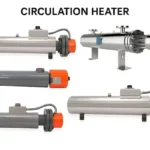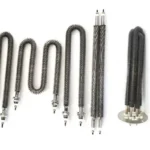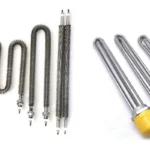
Fin Performance
Do you wonder why fins perform better in heating elements compared to regular materials? How is fin performance achieved through its principles? Do you know how to choose the right finned heaters for your industrial or residential needs? Through ELEKHEAT’s blog, you will gain a clear understanding.
Fin heating elements enhance heat transfer efficiency by increasing the surface area in contact with fluids, optimizing heat distribution, and improving overall thermal performance. This design ensures more efficient and uniform heating, significantly reducing heating time and energy consumption. It caters to a wide range of industrial and household heating needs, making it a versatile and energy-efficient solution.
Table of Contents
Heat Transfer Equation and Performance Analysis of Fins
Q = h ⋅ A⋅(Ts − T∞)
- Q: Heat transfer rate (W)
- h: Convective heat transfer coefficient (W/m²·K)
- A: Surface area of the fin (m²)
- Ts: Surface temperature of the fin (°C or K)
- T∞: Fluid temperature (°C or K)

Analysis of Fin Performance
Fins improve heat transfer by increasing the surface area that interacts with the surrounding fluid. For example, consider a heating element in a water heater designed to heat 50 liters of water from 20°C (T∞) to 60°C (Ts). Without fins, the heat transfer rate might be limited due to the smaller surface area. Adding fins increases the surface area from, say, 0.1 square meters to 0.3 square meters. This tripling of the area allows the heating element to transfer heat more efficiently, reducing the time required to reach the target temperature by up to 30%. This improvement is due to better utilization of the temperature difference (Ts−T∞) and an enhanced convective heat transfer coefficient (h).
Similarly, in an air-cooled condenser for industrial cooling, fins might increase the heat transfer area from 2 square meters to 6 square meters, improving the cooling rate significantly. For instance, if the original design could dissipate 5 kW of heat at a fluid temperature of 100°C (Ts) and ambient air at 30°C (T∞), the fins could increase this to 15 kW by optimizing both the surface area and airflow dynamics.
To achieve the best results, it is crucial to assess fin performance using metrics like fin efficiency and fin effectiveness, Elekheat can provide customized designs to suit specific application requirements.

Evaluation Metrics for Fin Performance
Fin Efficiency (ηf)
Definition: Fin efficiency is the ratio of the actual heat transfer rate (Qf) to the maximum theoretical heat transfer rate (Qmax).
ηf = Qf / Qmax
- A fin with zero length achieves an efficiency of 1, as it experiences no temperature drop along its length.
- For an infinitely long fin, efficiency approaches 0 due to the significant temperature decrease along its length, leading to minimal heat transfer near the far end.
Fin Effectiveness (ϵf)
ϵf = Qf / h⋅Ab⋅(Ts−T∞) Qf
- h: Convective heat transfer coefficient (W/m²⋅K)
- Ab: Base area (area without fins, m²)
- Ts: Surface temperature of the fin (°C or K)
- T∞: Fluid temperature (°C or K)
Impact of Fin Shape and Thickness
The perimeter-to-cross-section ratio (P/Ab) significantly affects fin performance. A higher P/Ab ratio increases the fin’s surface area exposed to the fluid, enhancing heat transfer efficiency. This is particularly crucial in applications with weak convection, such as gas-side heating.The experimental evidence is derived from studies on heat transfer performance with a focus on fin geometry.
Experimental Setup
- Fins Material: Aluminum (k=205 W/m\cdotpK).
- Fluid Medium: Air (convection coefficient h=25 W/m²\cdotpK).
- Thin Fin Dimensions: Perimeter P=0.4 m, Cross-sectional Area Ab=0.01m².
- Thick Fin Dimensions: Perimeter P=0.2 m, Cross-sectional Area Ab=0.02 m².
- Surface Temperature (Ts): 100℃
- Ambient Temperature (T∞): 25℃

| Parameter | Thin Fin | Thick Fin | Improvement |
|---|---|---|---|
| P/Ab Ratio | 40m−1 | 10 m−1 | +300% |
| Heat Transfer Rate (Q) | 150 W | 75 W | +100% |
| Efficiency (ηf) | 0.85 | 0.60 | +41.7% |
Thin fins perform exceptionally well in low-convection environments due to their higher P/Ab ratio, which increases the surface area available for heat transfer. In contrast, thick fins, while less efficient in transferring heat, are more suitable for high-convection or high-stress applications because of their greater structural strength and durability.

Elekheat Finned Heaters in Applications
Systematic Benefits of finned heaters by Elekheat
Elekheat’s finned heaters provide unmatched fin performance and are engineered to optimize heat transfer across diverse industries. By leveraging high-quality materials such as aluminum alloys with excellent thermal conductivity, Elekheat ensures fast and uniform heating while reducing energy costs. These industrial heating solutions are durable, with optimized fin designs that minimize wear and maintenance requirements.
In HVAC systems, fins improve the efficiency of heat exchangers and radiators. In the chemical and power industries, they maintain optimal temperatures in reactors and condensers. In automotive and aerospace sectors, fins manage complex thermal loads, ensuring equipment stability. Additionally, fins play a pivotal role in renewable energy by optimizing the performance of solar thermal panels.
Success Stories from Industry Partners

In the Food Service Industry, Elekheat partnered with Gourmet Solutions Inc., a leading restaurant chain in Europe, to address inconsistent baking results caused by uneven oven temperatures. Elekheat provided the ELEKHEAT SUS304 Straight Finned Heater, specifically designed to ensure uniform heat distribution. As a result, oven performance improved dramatically, reducing baking time by 20%, while the chain also reported a 15% reduction in energy costs.
In the Manufacturing Sector, Elekheat collaborated with ForgeTech Industries, a U.S.-based metal forging company, to resolve challenges related to uneven heating during high-temperature forging processes, which had led to material defects. Elekheat supplied the ELEKHEAT Band-Style Finned Heaters, equipped with helical fin designs to optimize heat distribution. This solution resulted in a 25% increase in production efficiency, a 30% reduction in material waste, and a 40% decrease in maintenance costs, significantly improving the company’s ROI.
In the Healthcare Industry, Elekheat partnered with MedClean Hospitals, a healthcare facility in Southeast Asia, to address unstable heating in its sterilization systems, which had compromised disinfection reliability. Elekheat installed ELEKHEAT U-Shaped Stainless Steel Finned Heaters, specifically designed for precision heating in medical applications. This solution ensured stable operation of the sterilization units, reducing equipment downtime by 50%.

Advancing Fin Performance in Finned Heaters
At ELEKHEAT, we continuously explore innovative fin geometries to enhance heat transfer performance. These heating solutions cater to diverse industrial and residential applications.
1. Stainless Steel-Based Finned Heaters
Products
- SUS304 Finned Air Heater
- Stainless Steel Finned Heater
- Stainless Steel U- and W-Shaped Finned Heaters
Features
High resistance to extreme temperatures and pressure. Improved heat dissipation for dry heating rods and irregular heating applications. Compact designs for enhanced heat transfer and performance.

Applications
These high-performance finned heaters are perfect for high-pressure sterilizers, dry heating processes, and efficient heat dissipation in industrial systems. Click here to get your Stainless Steel-Based Finned Heaters quote instantly!
2.High-Temperature Finned Strip Heaters
Product
High-Temperature Industrial Finned Strip Heater
Features
Durable design for use in demanding industrial environments with temperatures up to 500°F. Steel fins maximize surface area to enhance heat transfer and energy efficiency. Provides consistent thermal output for industrial processes like air heating and material drying.

Applications
Designed for industrial heating applications, including drying, air heating, and surface heating in environments requiring precise and consistent thermal output. Click here to get your High-Temperature Finned Strip Heater quote instantly!
3. Finned Tube Heaters
Product
Stainless Steel Finned Tube Heaters
Features
Perfect for use in aggressive environments prone to corrosion. Equipped with a special ceramic heating inset housed in a pressure-resistant, encapsulated housing, ensuring easy replacement and maintenance.Prevent exceeding the applicable temperature class, even in the event of errors like inadvertent covering.

Applications
Designed for frost protection and temperature maintenance in aggressive or corrosive environments, such as wastewater treatment plants, storage rooms, and instrumentation rooms. They can maintain room temperatures below 15°C while ensuring reliable performance in demanding industrial environments. Click here to get your Finned Tube Heaters quote instantly!
4. Customizable Finned Heaters
Products
- L-Shaped Finned Heater
- Double-Pipe and Single-Pipe Finned Heater
- Plate-Type Air Duct Finned Heater
Features
Fully customizable shapes, sizes, and materials (e.g., stainless steel, copper). Adjustable power and dimensions for diverse operational requirements. Optimized fin designs for efficient air heating and drying processes.

Applications
These versatile finned heaters are widely used in electric heating tubes, drying equipment, HVAC systems, and industrial heating solutions requiring specific configurations. Click here to get your Customizable Finned Heaters quote instantly!
Advancements in Material Science
ELEKHEAT is at the forefront of material innovation, incorporating advanced materials to enhance heat transfer efficiency:
- Graphene Coatings: With exceptional thermal conductivity (>4000 W/m\cdotpK), graphene reduces temperature gradients and significantly boosts heat dissipation.
- Composite Materials: Lightweight and high-conductivity composites are replacing traditional metals, offering a combination of efficiency and durability.
- Nano-Enhanced Coatings: By integrating nanoparticles into fin surfaces, we enhance surface energy, improving heat transfer rates in both liquids and gases.
These advancements represent ELEKHEAT’s commitment to leveraging material science breakthroughs to develop next-generation finned heaters.
Simulation and Modeling Optimization

At ELEKHEAT, we leverage state-of-the-art simulation and modeling tools to optimize fin performance. By utilizing high-precision computational fluid dynamics (CFD), we accurately model complex heat and fluid flow scenarios, enabling the development of fin designs that deliver maximum efficiency and reliability in real-world applications.
FAQ
Why are finned heaters more efficient?
They increase surface area, improving heat transfer and reducing energy use.
Why is Fin Performance important?
It ensures faster heat transfer, reduced energy use, and improved system efficiency.How is Fin Performance measured?
Using metrics like fin efficiency and fin effectiveness to evaluate heat transfer improvements.- Who benefits from finned heaters?
Industries like food service, manufacturing, and healthcare.
Contact Elekheat today by dialing 008618914757574 or use our contact form to discuss your heating element needs and improve your business’s efficiency and bottom line.
References
Massachusetts Institute of Technology. (n.d.). Heat Transfer from a Fin. MIT OpenCourseWare. Retrieved from https://web.mit.edu/16.unified/www/FALL/thermodynamics/notes/node128.html
Florida State University, Department of Mechanical Engineering. (n.d.). Extended Surface (Fin) Heat Transfer. Lecture Notes. Retrieved from https://web1.eng.famu.fsu.edu/~alvi/eml4304/webpage_old/documents/fin_transfer/Fin_lecture.pdf
- Xia, Z., Bai, X., & Li, X. (2020). Fin optimization in heat transfer applications: A simulation-based approach. arXiv preprint. Retrieved from https://arxiv.org/abs/2010.14506





